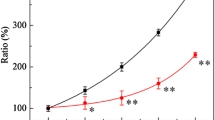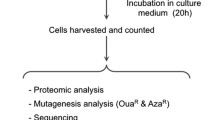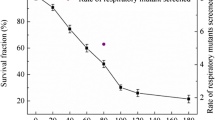Abstract
Heavy-ion beam (HIB) irradiation has been widely used in microbial mutation breeding. However, a global cellular response to such radiation remains mostly uncharacterised. In this study, we used transcriptomics to analyse the damage repair response in Saccharomyces cerevisiae following a semi-lethal HIB irradiation (80 Gy), which induced a significant number of DNA double-strand breaks. Our analysis of differentially expressed genes (DEGs) from 50 to 150 min post-irradiation revealed that upregulated genes were significantly enriched for gene ontology and Kyoto encyclopaedia of genes and genomes terms related to damage repair response. Based on the number of DEGs, their annotation, and their relative expression, we established that the peak of the damage repair response occurred 75 min post-irradiation. Moreover, we exploited the data from our recent study on X-ray irradiation-induced repair to compare the transcriptional patterns induced by semi-lethal HIB and X-ray irradiations. Although these two radiations have different properties, we found a significant overlap (> 50%) for the DEGs associated with five typical DNA repair pathways and, in both cases, identified homologous recombination repair (HRR) as the predominant repair pathway. Nevertheless, when we compared the relative enrichment of the five DNA repair pathways at the key time point of the repair process, we found that the relative enrichment of HRR was higher after HIB irradiation than after X-ray irradiation. Additionally, the peak stage of HRR following HIB irradiation was ahead of that following X-ray irradiation. Since mutations occur during the DNA repair process, uncovering detailed repair characteristics should further the understanding of the associated mutagenesis features.










Similar content being viewed by others
References
Brenner DJ (2008) The linear-quadratic model is an appropriate methodology for determining isoeffective doses at large doses per fraction. Semin Radiat Oncol 18(4):234–239. https://doi.org/10.1016/j.semradonc.2008.04.004
Cao GZ, Lu D, Zhang MM, Wang J, Ma L, Li X, Li WJ (2013) The research progress of DNA damages repair pathways induced by heavy ion irradiation in Saccharomyces cerevisiaes. Acta Laser Biology Sinica 22(3):201–209
Chen LW, Tang HQ, Du Y, Dai ZY, Wang T, Wu LJ, Zhou LB, Bian P (2018) Induction of reproductive cell death in Caenorhabditis elegans across entire linear-energy-transfer range of carbon-ion irradiation. DNA Repair 63:39–46. https://doi.org/10.1016/j.dnarep.2018.01.009
Chen LJ, Yuan DF, Yang YC, Ren MZ (2019) LincRNA-p21 enhances the sensitivity of radiotherapy for gastric cancer by targeting the β-catenin signaling pathway. J Cell Biochem 120(4):6178–6187. https://doi.org/10.1002/jcb.27905
Dai TY, Li Q, Liu XG, Dai ZY, He PB, Ma YY, Shen GS, Chen WQ, Zhang H, Meng QQ, Zhang XF (2019) Nanodosimetric quantities and RBE of a clinically relevant carbon-ion beam. Med Phys. https://doi.org/10.1002/mp.13914
Dietze G, Bartlett DT, Cool DA, Cucinotta FA, Jia X, McAulay IR, Pelliccioni M, Petrov V, Reitz G, Sato T, Task Group on Radiation Protection in Space IC (2013) ICRP, 123. Assessment of radiation exposure of astronauts in space. ICRP publication 123. Ann ICRP 42(4):1–339. https://doi.org/10.1016/j.icrp.2013.05.004
Du Y, Luo S, Li X, Yang J, Cui T, Li W, Yu L, Feng H, Chen Y, Mu J (2017) Identification of substitutions and small insertion-deletions induced by carbon-ion beam irradiation in Arabidopsis thaliana. Front Plant Sci 8:1851. https://doi.org/10.3389/fpls.2017.01851
Engel SR, Weng S, Binkley G, Paskov K, Song G, Cherry JM (2016) From one to many: expanding the Saccharomyces cerevisiae reference genome panel. Database:5. https://doi.org/10.1093/database/baw020
Fisk DG, Ball CA, Dolinski K, Engel SR, Hong EL, Issel-Tarver L, Schwartz K, Sethuraman A, Botstein D, Cherry JM, Sacchoromyces Genome Database P (2006) Saccharomyces cerevisiae S288C genome annotation: a working hypothesis. Yeast 23(12):857–865. https://doi.org/10.1002/yea.1400
Ginestet C (2011) ggplot2: elegant graphics for data analysis. J R Stat Soc Ser A-Stat Soc 174:245–245. https://doi.org/10.1111/j.1467-985X.2010.00676_9.x
Guo X, Zhang M, Gao Y, Li W, Lu D (2018) Determining survival fractions of Saccharomyces cerevisiae in response to ionizing radiation in liquid culture. J Radiat Res 59(6):760–764. https://doi.org/10.1093/jrr/rry070
Guo XP, Zhang MM, Gao Y, Cao GZ, Yang Y, Lu D, Li WJ (2019a) A genome-wide view of mutations in respiration-deficient mutants of Saccharomyces cerevisiae selected following carbon ion beam irradiation. Appl Microbiol Biotechnol 103(4):1851–1864. https://doi.org/10.1007/s00253-019-09626-0
Guo XP, Zhang MM, Gao Y, Li WJ, Lu D (2019b) “Saddle-shaped” dose-survival effect, is it a general and valuable phenomenon in microbes in response to heavy ion beam irradiation? Ann Microbiol 69(3):221–232. https://doi.org/10.1007/s13213-019-1442-7
Guo XP, Zhang MM, Liu RY, Gao Y, Yang Y, Li WJ, Lu D (2019c) Repair characteristics and time-dependent effects in Saccharomyces cerevisiae cells after X-ray irradiation. World J Microbiol Biotechnol 35(1):15–15. https://doi.org/10.1007/s11274-018-2566-9
Hagiwara Y, Oike T, Niimi A, Yamauchi M, Sato H, Limsirichaikul S, Held KD, Nakano T, Shibata A (2019) Clustered DNA double-strand break formation and the repair pathway following heavy-ion irradiation. J Radiat Res 60(1):69–79. https://doi.org/10.1093/jrr/rry096
Hall EJ, Giaccia AJ (2006) Radiobiology for the radiologist. Lippincott Williams & Wilkins, Philadelphia
He YX, Zhang Y, Li HY, Zhang H, Li ZS, Xiao LF, Hu JJ, Ma YJ, Zhang QW, Zhao XX (2018) Comparative profiling of microRNAs reveals the underlying toxicological mechanism in mice testis following carbon ion radiation. Dose-Response 16(2):12. https://doi.org/10.1177/1559325818778633
He YX, Li HY, Zhang Y, Hu JJ, Shen YL, Feng J, Zhao XX (2019) Comparative analysis of mitochondrial proteome reveals the mechanism of enhanced ram sperm motility induced by carbon ion radiation after in vitro liquid storage. Dose-Response 17(1):13. https://doi.org/10.1177/1559325818823998
Hefferin ML, Tomkinson AE (2005) Mechanism of DNA double-strand break repair by non-homologous end joining. DNA Repair 4(6):639–648. https://doi.org/10.1016/j.dnarep.2004.12.005
Kennedy AR, Zhou ZZ, Donahue JJ, Ware JH (2006) Protection against adverse biological effects induced by space radiation by the Bowman-Birk inhibitor and antioxidants. Radiat Res 166(2):327–332. https://doi.org/10.1667/rr3599.1
Kubo N, Saitoh J, Shimada H, Shirai K, Kawamura H, Ohno T, Nakano T (2016) Dosimetric comparison of carbon ion and X-ray radiotherapy for stage IIIA non-small cell lung cancer. J Radiat Res 57(5):548–554. https://doi.org/10.1093/jrr/rrw041
Lang OW, Nash RS, Hellerstedt ST, Engel SR, Project SGD (2018) An introduction to the Saccharomyces genome database (SGD). Methods Mol Bio (Clifton, Nj) 1757:21–30. https://doi.org/10.1007/978-1-4939-7737-6_2
Li P, Zhou LB, Jin XD, He J, Dai ZY, Zhou GM, Gao QX, Li S, Lia Q (2008) Assessment of DNA damage of Lewis lung carcinoma cells irradiated by carbon ions and X-rays using alkaline comet assay. Nucl Instrum Methods Phys Res Sect B-Beam Interact Mater Atoms 266(2):262–266. https://doi.org/10.1016/j.nimb.2007.11.021
Li HK, Matsumoto Y, Furusawa Y, Kamada T (2016) PU-H71, a novel Hsp90 inhibitor, as a potential cancer-specific sensitizer to carbon-ion beam therapy. J Radiat Res 57(5):572–575. https://doi.org/10.1093/jrr/rrw054
Li X, Wang J, Tan ZL, Ma L, Lu D, Li WJ, Wang JF (2018) Cd resistant characterization of mutant strain irradiated by carbon-ion beam. J Hazard Mater 353:1–8. https://doi.org/10.1016/j.jhazmat.2018.03.036
Li JB, Sun HZ, Huang YL, Wang YL, Liu YY, Chen XF (2019) Pathways and assays for DNA double-strand break repair by homologous recombination. Acta Biochim Biophys Sin 51(9):879–889. https://doi.org/10.1093/abbs/gmz076
Liu F, Wang ZZ, Li WJ, Wei W, Dang BR (2018) Assessment of mouse BMMNC DNA damage with a two-tailed comet assay after X-ray and carbon ion total body irradiation. Nucl Sci Tech 29(6):8–8. https://doi.org/10.1007/s41365-018-0421-1
Liu F, Wang ZZ, Li WJ, Wei YT (2019a) Transcriptional response of murine bone marrow cells to total-body carbon-ion irradiation. Mutat Res Genet Toxicol Environ Mutagen 839:49–58. https://doi.org/10.1016/j.mrgentox.2019.01.014
Liu F, Wang ZZ, Li WJ, Zhou LB, Du Y, Zhang MM, Wei YT (2019b) The mechanisms for the radioprotective effect of β-D-glucan on high linear-energy-transfer carbon ion irradiated mice. Int J Biol Macromol 131:282–292. https://doi.org/10.1016/j.ijbiomac.2019.03.073
Lu T, Zhang Y, Wong M, Feiveson A, Gaza R, Stoffle N, Wang HC, Wilson B, Rohde L, Stodieck L, Karouia F, Wu HL (2017) Detection of DNA damage by space radiation in human fibroblasts flown on the international space station. Life Sci Space Res 12:24–31. https://doi.org/10.1016/j.lssr.2016.12.004
Matuo Y, Nishijima S, Hase Y, Sakamoto A, Tanaka A, Shimizu K (2006) Specificity of mutations induced by carbon ions in budding yeast Saccharomyces cerevisiae. Mutat Res-Fundam Mol Mech Mutagen 602(1–2):7–13. https://doi.org/10.1016/j.mrfmmm.2006.07.001
Matuo Y, Izumi Y, Furusawa Y, Shimizu K (2018) Biological effects of carbon ion beams with various LETs on budding yeast Saccharomyces cerevisiae. Mutat Res-Fundam Mol Mech Mutagen 810:45–51. https://doi.org/10.1016/j.mrfmmm.2017.10.003
Mohamad O, Makishima H, Kamada T (2018) Evolution of carbon ion radiotherapy at the national institute of radiological sciences in Japan. Cancers 10(3):22. https://doi.org/10.3390/cancers10030066
Mortezaee K, Goradel NH, Amini P, Shabeeb D, Musa AE, Najafi M, Farhood B (2019) NADPH oxidase as a target for modulation of radiation response; implications to carcinogenesis and radiotherapy. Curr Mol Pharmacol 12(1):50–60. https://doi.org/10.2174/1874467211666181010154709
Oeck S, Al-Refae K, Riffkin H, Wiel G, Handrick R, Klein D, Iliakis G, Jendrossek V (2017) Activating Akt1 mutations alter DNA double strand break repair and radiosensitivity. Sci Rep 7:11–11. https://doi.org/10.1038/srep42700
Song LH, Ma LJ, Cong FS, Shen XH, Jing P, Ying X, Zhou HY, Jiang J, Fu YY, Yan HL (2015) Radioprotective effects of genistein on HL-7702 cells via the inhibition of apoptosis and DNA damage. Cancer Lett 366(1):100–111. https://doi.org/10.1016/j.canlet.2015.06.008
Strimmer K (2008) fdrtool: a versatile R package for estimating local and tail area-based false discovery rates. Bioinformatics 24(12):1461–1462. https://doi.org/10.1093/bioinformatics/btn209
Suman S, Kumar S, Fornace AJ, Datta K (2018) The effect of carbon irradiation is associated with greater oxidative stress in mouse intestine and colon relative to gamma-rays. Free Radic Res 52(5):556–567. https://doi.org/10.1080/10715762.2018.1452204
Tanaka A, Shikazono N, Hase Y (2010) Studies on biological effects of ion beams on lethality, molecular nature of mutation, mutation rate, and spectrum of mutation phenotype for mutation breeding in higher plants. J Radiat Res 51(3):223–233. https://doi.org/10.1269/jrr.09143
Wang D, Gao F (2019) Comprehensive analysis of replication origins in Saccharomyces cerevisiae genomes. Front Microbiol 10:1–10. https://doi.org/10.3389/fmicb.2019.02122
Wang YQ, Song FH, Zhu JW, Zhang SS, Yang YD, Chen TT, Tang BX, Dong LL, Ding N, Zhang Q, Bai ZX, Dong XN, Chen HX, Sun MY, Zhai S, Sun YB, Yu L, Lan L, Xiao JF, Fang XD, Lei HX, Zhang Z, Zhao WM (2017) GSA: genome sequence archive. Genomics Proteomics Bioinformatics 15(1):14–18. https://doi.org/10.1016/j.gpb.2017.01.001
Wong ED, Skrzypek MS, Weng S, Binkley G, Meldal BHM, Perfetto L, Orchard SE, Engel SR, Cherry JM, Project SGD (2019) Integration of macromolecular complex data into the Saccharomyces genome database. Database:5. https://doi.org/10.1093/database/baz008
Wright WD, Shah SS, Heyer WD (2018) Homologous recombination and the repair of DNA double-strand breaks. J Biol Chem 293(27):10524–10535. https://doi.org/10.1074/jbc.TM118.000372
Xia JW, Zhan WL, Wei BW, Yuan YJ, Zhao HW, Yang JC, Shi J, Sheng LN, Yang WQ, Mao LJ (2016) Heavy ions research facility in Lanzhou (HIRFL). Chin Sci Bull 61(4/5):467–477
Yan Q, Wu F, Ma TT, Zong XF, Ma Q, Li J, Zhao YF, Wang YR, Zhang JY (2019a) Comprehensive analysis of bZIP transcription factors uncovers their roles during dimorphic floret differentiation and stress response in Cleistogenes songorica. BMC Genomics 20(1):17. https://doi.org/10.1186/s12864-019-6092-4
Yan Q, Wu F, Yan ZZ, Li J, Ma TT, Zhang YF, Zhao YF, Wang YR, Zhang JY (2019b) Differential co-expression networks of long non-coding RNAs and mRNAs in Cleistogenes songorica under water stress and during recovery. BMC Plant Biol 19:19–19. https://doi.org/10.1186/s12870-018-1626-5
Yoshimoto Y, Oike T, Okonogi N, Suzuki Y, Ando K, Sato H, Noda S, Isono M, Mimura K, Kono K, Nakano T (2015) Carbon-ion beams induce production of an immune mediator protein, high mobility group box 1, at levels comparable with X-ray irradiation. J Radiat Res 56(3):509–514. https://doi.org/10.1093/jrr/rrv007
Young MD, Wakefield MJ, Smyth GK, Oshlack A (2010) Gene ontology analysis for RNA-seq: accounting for selection bias. Genome Biol 11(2):R14. https://doi.org/10.1186/gb-2010-11-2-r14
Yu G, Wang L-G, Han Y, He Q-Y (2012) clusterProfiler: an R package for comparing biological themes among gene clusters. Omics 16(5):284–287. https://doi.org/10.1089/omi.2011.0118
Zhang HD, Lu D, Li X, Feng YG, Cui Q, Song XJ (2018a) Heavy ion mutagenesis combined with triclosan screening provides a new strategy for improving the arachidonic acid yield in Mortierella alpina. BMC Biotechnol 18:9–9. https://doi.org/10.1186/s12896-018-0437-y
Zhang MM, Cao GZ, Guo XP, Gao Y, Li WJ, Lu D (2018b) A comet assay for DNA damage and repair after exposure to carbon-ion beams or X-rays in Saccharomyces cerevisiae. Dose-Response 16(3):9. https://doi.org/10.1177/1559325818792467
Zhang Z, Zhao WM, Xiao JF, Bao YM, Wang F, Hao LL, Zhu JW, Chen TT, Zhang SS, Chen X, Tang BX, Zhou Q, Wang ZH, Dong LL, Wang YQ, Ma YK, Zhang ZW, Wang Z, Chen ML, Tian DM, Li CP, Teng XF, Du ZL, Yuan N, Zeng JY, Wang JY, Shi S, Zhang YD, Wang Q, Pan MY, Qian QH, Song SH, Niu GY, Li M, Xia L, Zou D, Zhang YS, Sang J, Li MW, Zhang Y, Wang P, Gao QW, Liang F, Li RJ, Liu L, Cao J, Abbasi AA, Shireen H, Li Z, Xiong Z, Jiang MY, Guo TK, Li ZH, Zhang H, Ma L, Gao R, Zhang T, Li WL, Zhang XQ, Lan L, Zhai S, Zhang YP, Wang GD, Wang ZN, Xue YB, Sun YB, Yu L, Sun MY, Chen HX, Hu H, Guo AY, Lin SF, Xue Y, Wang CW, Ning WS, Zhang Y, Luo H, Gao F, Guo YP, Zhang Q, Zhou JQ, Huang Z, Cui QH, Miao YR, Ruan C, Yuan CH, Chen M, Jinpu J, Gao G, Xu HD, Li YM, Li CY, Tang Q, Peng D, Deng WK, Big Data Ctr M (2019) Database resources of the BIG data center in 2019. Nucleic Acids Res 47(D1):D8–D14. https://doi.org/10.1093/nar/gky993
Zhou LB, Li WJ, Yu LX, Li P, Li Q, Ma S, Dong XC, Zhou GM, Leloup C (2006) Linear energy transfer dependence of the effects of carbon ion beams on adventitious shoot regeneration from in vitro leaf explants of Saintpaulia ionahta. Int J Radiat Biol 82(7):473–481. https://doi.org/10.1080/09553000600863080
Acknowledgements
We thank the colleagues at HIRFL for providing high-quality carbon ion beam irradiation.
Funding
This work was supported by the National Natural Science Foundation of China (No. 11975284), the National Natural Science Foundation of China (No. 11905265), the Joint project of the Chinese Academy of Sciences and the Industrial Technology Research Institute (CAS-ITRI 2019012), and the Science and Technology Program of Lanzhou, China (2019-1-39).
Author information
Authors and Affiliations
Corresponding author
Ethics declarations
Conflict of interest
The authors declare that they have no conflicts of interest.
Human and animal rights
This article does not contain any studies with human participants or animals performed by any of the authors.
Additional information
Publisher’s note
Springer Nature remains neutral with regard to jurisdictional claims in published maps and institutional affiliations.
Rights and permissions
About this article
Cite this article
Guo, X., Zhang, M., Gao, Y. et al. Repair characteristics and time-dependent effects in response to heavy-ion beam irradiation in Saccharomyces cerevisiae: a comparison with X-ray irradiation. Appl Microbiol Biotechnol 104, 4043–4057 (2020). https://doi.org/10.1007/s00253-020-10464-8
Received:
Revised:
Accepted:
Published:
Issue Date:
DOI: https://doi.org/10.1007/s00253-020-10464-8




